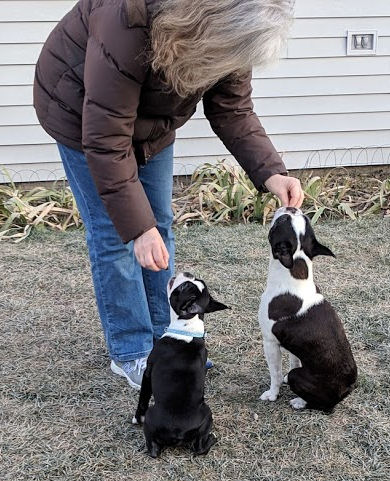It’s not your imagination. Dogs are copycats. Your dog copies what you do. Copying is one of the ways dogs learn. And it’s not restricted to watching and imitating other dogs. Dogs mimic people, too. That’s why you shouldn’t be surprised if your dog starts digging in the yard after “helping” you with gardening.
Even more impressive, one study proved that dogs not only can copy what you do – they can do it with a significant delay between the time it happened and they’re asked to repeat it.
Demonstrate what you want
A while ago, when we were first developing the Ring Stacking game, Hope was teaching her French Bulldog Teddy the steps. We’d just started taking video of the sessions, so the camera was on.
Teddy had just about all pieces of the game; picking up the ring and going over to the post. The actual placement of the ring on the post was the issue. He kept nudging the post, dropping the ring in the vicinity, but not placing it on the actual post.
In the video, you see Hope showing Teddy what she wants. She probably was doing it out of frustration, rather than really demonstrating. But then you see Teddy stand there and think about it, then place the ring precisely on the post.
At the time, we didn’t know for sure that dogs learn by copying. But it paid off.
Other dogs show them how
It’s true that puppies learn from an older dog in the house. Potty training is much easier when the newcomer has an example to follow. Same with other household rules – most puppies will follow the lead of the established dog. That’s a big reason that two dogs are easier than one, although not if both are the same age. Or littermates. For most people, getting littermates isn’t a great idea.
It’s optimal to play training games with only one dog at a time. But that doesn’t mean training in isolation. With four dogs in the house, three are in crates at the side of the training area, watching the proceedings.
Did you teach him that?

Sometimes when we’re ready to introduce a dog to a game another dog knows, we’ve been surprised. While performance isn’t perfect, the dog already knows the game. It prompts a discussion that goes
“Did you teach him that? I didn’t teach him that!”
“Wasn’t me!”
“Oh, he got it from his brother!”
Try it for yourself
Think of something to do that your dog can copy. In the research we read, one of the things owners did in the lab was stick their heads in an empty bucket. A vast majority of the dogs in the study were able to copy the action after seeing it only once.
Make sure the demonstration is something the dog is physically able to do. Our dogs are too short to get their heads in a five-gallon bucket, so we’ll use something lower. Give the action a name, like “Copy!” using it for all kinds of different actions.
That’s how you teach the dog to mimic you, rather than performing a specific behavior. We’ve even seen it in action with the dolphins at the Dolphin Research Center in Marathon, Florida. The trainers there use a specific signal for “Imitate!”
In no time, you and your dog will be playing “Simon Says!” with all sorts of behaviors. Be sure to get it on video – you’ll need proof of your dog’s genius!

